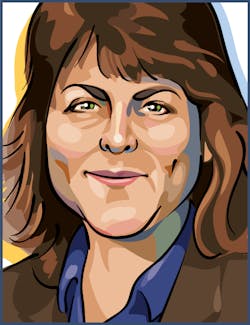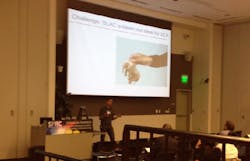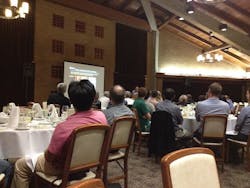
From September 16-18, I was fortunate enough to attend the 2013 Stanford Photonics Research Center (SPRC) Symposium, held on the fabulous grounds of Stanford University. I had forgotten just how beautiful and large (yes, buses needed) the campus is, and it was great to mingle with the students returning from summer break.
The Symposium, as in previous years, always brings together the best photonics technology presentations from some of the most influential individuals in academia and industry. Monday began with an introduction by SPRC executive director Tom Baer, followed by welcome remarks from Anton Muscatelli, principal of the University of Glasgow, who gave an overview of the SU2P Industrial Affiliates Program (http://www.su2p.com/)—a partnership between program members Coherent, Optos, M Squared, Thales, Selex Galileo, and mLED, as well as academic partners Caltech, Heriot Watt University, University of Glasgow, University of St. Andrews, Stanford University, and University of Strathclyde Glasgow. The SU2P partnership aims to initiate development projects, fellowships, and research exchanges between Scottish industry/academia and US industry/academia, specifically in the life science and renewable energy fields concerning photonics. The 80 or so attendees at SPRC day 1 listened as Muscatelli explained "How nonlinear the progress of science is", meaning that some advances happen rapidly while others languish.
Eric Mazur of Harvard University, in the opening plenary, described "Black Silicon: From Serendipitous Discovery to Devices," highlighting just how this particular technology moved rather rapidly from femtosecond laser writing novelty to actual commercial device development with companies like SiOnyx.
The morning presentations focused on X-ray and ultrafast technology, with UC Berkeley's Feng Wang discussing "Turntable Ultrafast Responses in Graphene," meaning that doped graphene can alternate between metal-like and semiconductor-like behavior. Stanford's Alexander Gray followed with a presentation on how vanadium oxide could potentially be used to make a faster, more energy efficient field-effect transistor (FET) by "Separating Electronic and Structural Phase Transitions in VO2 with THz-Pump X-Ray Probe Spectroscopy," and UCLA's Chan Joshi described "Recent Advanes in Laser Acceleration of Particles" and how lasers like BELLA could potentially lead to 100 GeV/m accelerations versus 10 MeV/m for conventional accelerators. Stanford's Edgar Peralta (shown in the image below), followed Joshi with a presentation on "Electron Acceleration in a Laser-Driven Dielectric Micro-Structure" wherein high-gradient acceleration of electrons has been demonstrated in a lithographically fabricated dielectric laser accelerator (DLA) cavity driven by a Ti:sapphire laser. Accelerators have a long history, with the earliest ones in 1947 achieving a 2 MeV/m gradient in a 1 m long cavity, while the DLA has a 300 MeV/m gradient inside a 0.001 m long cavity—an effort that has been 60 plus years in the making!
The morning sessions concluded with one-minute long, always impressive poster presentations from nearly 20 Stanford students on their particular areas of research. Look for news stories and newsbreaks in upcoming issues of Laser Focus World covering ultrabroadband photonic structures for daytime radiative cooling, graded-index and non-tracking sola concentrators, and an optical blood-coagulation sensor.
Continuing with the X-ray theme, an all-laser-driven Compton X-ray light source, compressive X-ray tomography, and a photoelectron X-ray source array were presented in the afternoon before the final "Emerging Technologies" sessions, which included presentations on concentrated photovoltaics from Solar Junction, stretchable polymer OLEDs from UCLA, and a review of novel photovoltaic (PV) materials from Du Pont.
After a long, but fruitful day, the crowd walked (and walked) to the Stanford Faculty Club for a banquet (see image below) and an amusing presentation entitled "Gravity from the Cradle to the Grave" in which Jim Hough of Glasgow University opened his presentation with a short video of the Star Trek episode on gravity waves featuring Captain Jean-Luc Picard. Hough swears to this day he witnessed a gravity wave decades ago and that the excitement of that event was enough to keep him continuing his search for the elusive phenomenon to this very day.
Please watch this PHOTON FOCUS Blog space as I summarize SPRC Days 2 and 3, which focused on biophotonics and industrial lasers, respectively.

Gail Overton | Senior Editor (2004-2020)
Gail has more than 30 years of engineering, marketing, product management, and editorial experience in the photonics and optical communications industry. Before joining the staff at Laser Focus World in 2004, she held many product management and product marketing roles in the fiber-optics industry, most notably at Hughes (El Segundo, CA), GTE Labs (Waltham, MA), Corning (Corning, NY), Photon Kinetics (Beaverton, OR), and Newport Corporation (Irvine, CA). During her marketing career, Gail published articles in WDM Solutions and Sensors magazine and traveled internationally to conduct product and sales training. Gail received her BS degree in physics, with an emphasis in optics, from San Diego State University in San Diego, CA in May 1986.


